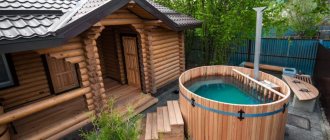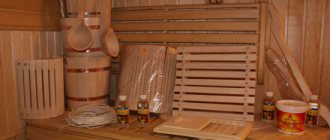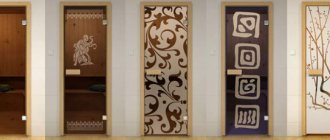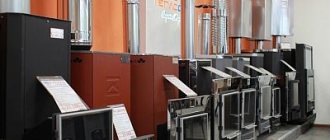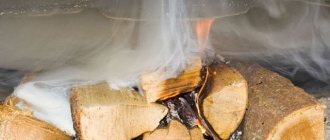Home » Building a house
Building a houseBuilding materialsConstruction and repair
Alexander Korovaev 04/30/2020
7747 Views 1 comment
SavingSavedRemoved 1
The bathhouse in Rus' has long enjoyed well-deserved respect. It was believed that regular visits to the steam room not only improve health, but also promote spiritual cleansing. Special materials were used for its construction. Let’s try to figure out what is best to build a bathhouse from.
Frame
Frame-panel structures became popular among consumers several years ago. They are quite easy to assemble and do not require a large amount of natural wood or special equipment.
An inexpensive frame bathhouse is placed on a lightweight foundation, most often a columnar one is chosen. This significantly reduces construction costs since it does not require as much concrete to pour the foundation.
The walls of the bathhouse are most often mounted from ready-made frames, which are immediately manufactured in the workshop. If desired, to further reduce costs, you can assemble the frame yourself, but this will slow down construction. To create good thermal insulation and for a long service life of the building, it should be sheathed with suitable boards. To save money, coniferous species are suitable.
Attention! For frame baths, timber and logs are often used. But these materials are very expensive, although they are of excellent quality and long service life. Unplaned timber will allow you to save as much as possible on material. It is not as beautiful, but very affordable.
Since frame baths have thin walls, they require mandatory insulation. Among inexpensive insulation materials, mineral wool is most often chosen. It is laid in the walls in the form of slabs. They are not only affordable, but are also reliable and have a long service life, provided they are installed well.
Attention! When building frame-panel baths, you cannot skimp on protecting the frame and vapor barrier. If you have very little money, then give your preference to polymer film and aluminum foil. They are quite hopeful and belong to the economy segment.
Twinblock – “mineral wood”
Why do we love wood? Firstly, this is a natural material! Secondly, wood is environmentally friendly!
What about Twinblock? Its composition includes water, lime, Portland cement PC-500 and ash to increase strength. The radiation background of Twinblock is almost five times lower than the maximum permissible norm specified in GOSTs: the effective specific activity of natural radionuclides of Twinblock is 55-77.5 Bq/kg, and the maximum permissible level is 370 Bq/kg.
Houses made from Twin Block are more environmentally friendly than houses made from aerated block, in the production of which quartz sand is used rather than ash, and even houses made from brick. It is no coincidence that Twinblock is called “mineral wood”. A Twinblock sauna will be environmentally friendly!
By the way, about wood: “modern wood” is often different from the one from which houses and bathhouses were cut 100 years ago - now it is processed and impregnated... As a result, the material can hardly be called natural and natural. Is it environmentally friendly? It depends on the honesty of the manufacturer.
From cinder blocks
Such baths began to be built not so long ago. They are very affordable, easy to build and last longer than wooden ones. Such structures require good insulation and mandatory vapor barrier. It is especially important to approach this issue if your latitude experiences constant temperature changes and cold winters.
Cinder block does not require additional protection against mold or mildew, which allows you to save on treating walls with an antiseptic. Also, cinder blocks do not burn, which eliminates the need to use fire retardants. There are several types of cinder blocks.
Expert opinion
Lovkachev Boris Petrovich
Bath master who knows everything about steaming
Attention! Cinder blocks can have different compositions; you should definitely familiarize yourself with them before purchasing. The best composition is shell rock, sand, expanded clay, sawdust and crushed stone, which are fixed with cement.
For supporting structures, it is advisable to choose monolithic blocks. They are strong and will enhance the load-bearing properties of the walls. For external walls, it is recommended to choose blocks with voids occupying 30% of the block volume. Internal partitions are erected from small blocks weighing 10-13 kg with a minimum thickness. This is necessary to save space indoors.
In addition, the internal walls rarely act as load-bearing walls, which eliminates the need for their significant strengthening. The same materials can be used as insulation and vapor barrier as for a frame bath.
To build baths from cinder blocks, you also do not need an expensive foundation, which allows you to save up to 50% of the budget. Usually a columnar or strip base is chosen.
The main thing is that it is perfectly aligned horizontally to avoid movement and deformation of the walls. If you violate the foundation laying technology, large cracks will appear on the cinder blocks.
Attention! Cinder block baths are not suitable for everyone. They are characterized by increased sound permeability. To eliminate this drawback, additional sound insulation will be required. It is worth calculating what is more profitable in this case: to build a bathhouse of a different type or to build a structure made of cinder blocks.
Nuances of choosing material
It must be taken into account that quite strict requirements are imposed on the construction of baths. This is due to the fact that they are often heated with wood. There are a small number of criteria when choosing a material, but they must be taken into account, otherwise the functionality of the bathhouse can be quite impaired, and its use will be expensive and inconvenient.
When choosing what is best to build a bathhouse from, you will need to take into account a number of certain criteria. In addition to strength, materials must have the following characteristics:
- Thermal insulation properties. Thanks to this, it will be possible to maintain the microclimate of the bathhouse without unnecessary costs of firewood or any other fuel.
- Protection against severe temperature changes and high humidity levels.
Bathhouse design Source dcgate.pp.ua
In addition to the parameters considered, the choice of material is also influenced by the size of the future building, its location on the ground and the financial capabilities of the developer. It is also extremely important to consider the quality of the products purchased. So, the wood must have average humidity and high-quality processing. In addition to wood, a large number of materials are used, each of which has its own strengths and weaknesses.
Foam block
This material also began to be in demand for the construction of baths not so long ago, but has already earned its respect among consumers. Foam block structures are lightweight and do not require the construction of a serious foundation.
Despite the fact that foam blocks retain heat well, you should definitely take care of good thermal insulation. It is especially important to think about it in case of severe winters. Foam block baths are not afraid of fire, which allows you to save on fire retardants, while the material does not crumble even at very high temperatures.
The strengths of foam block baths are their rapid erection, naturalness of the material and ease of cladding. The environmental friendliness of the materials eliminates the release of toxins and harmful substances when heated. And the low cost makes it possible to compete with other materials, gradually displacing even wood.
Attention! When using wooden slats or any wood elements as cladding for foam blocks, they should still be carefully processed for fire safety and protection from rotting.
Wooden buildings
The first such structures in Rus' were made of stone, but gradually the builders realized that wood retains precious heat much longer. Plus, in such buildings it is much easier to maintain the required level of humidity and natural ventilation.
Wooden bathhouse buildings
After all, thanks to the smallest capillaries, this material quickly and easily absorbs excess moisture and just as easily releases it into the room if necessary. Therefore, if you are in doubt about what material is best to build a bathhouse from, choose wood - you can’t go wrong.
Main tree species used for construction
The Russian bath differs from saunas and Asian hammams in its high humidity. Therefore, the most moisture-resistant wood is selected for construction. Pine, larch, and spruce are most suitable for these purposes. Dense pine wood is less susceptible to moisture and mold. In addition, due to the content of adhesive resin, buildings made from it do not crack when dry and last for decades.
Rounded larch log
What kind of wood is best to build a bathhouse from? Larch is the least susceptible to rotting. Before the advent of other building materials, river bridges were built from it. This is the only wood that does not collapse even under the influence of sea water. The wear resistance of larch is also high.
In Europe, floors assembled from it 300-400 years ago have survived to this day! Over time, such a tree not only did not collapse, but also acquired the strength of a stone.
Pine is less dense and weighs less than expensive larch, but can be processed much better. Over time, it turns yellow, while the more expensive and more massive larch becomes brownish-red. It is from pine that the largest number of private household buildings were erected in Russia, which is rich in forests.
Pine log house
You can distinguish pine by running your fingernail or a sharp object across the surface - no trace will remain on larch, whereas a small groove will appear on pine. Pine has a characteristic resinous odor. Larch does not have it. Due to the high resin content, it is not worth using pine for the interior decoration of baths - when it is heated, hot drops appear on the surface. Only log houses are built from it.
The air in rooms built from spruce logs is unusually clean. But due to its low density, this tree is less wear-resistant, and therefore requires additional treatment to prevent rotting. For this reason, the cost of spruce is lower than pine. Since spruce boards weigh little, they are often used for roofing. It is not recommended to use such wood for finishing inside a bathhouse - when heated, it begins to “cry”.
Oak and aspen are used from deciduous trees for the construction of baths. Rot-resistant noble oak is especially valued. Its texture is velvety and its color is slightly creamy. But, since the price of oak is high, it is used more for interior decoration - it, like cedar, is absolutely not afraid of elevated temperatures.
Outwardly less attractive than oak, aspen is not much inferior to it in density. Like larch, it only increases strength over time. A characteristic feature of aspen products is their bright red hue. A log house made from it will last for many years. It is not advisable to use inexpensive linden both for log houses and for finishing steam rooms. It holds heat excellently, but is very afraid of fungus. Plus, without additional coating it gets dark quickly.
timber
Glued laminated timber on a cut
Timber Which bathhouse is better to build? During the drying process, wood often cracks, so for the construction of log houses it is better to use not a log, but a denser 100-200 mm laminated veneer lumber. Ideally, it is better to use material that has been chamber dried. During this treatment, it becomes virtually invulnerable to cracks.
When using profiled (with interlocking) timber, the building can be assembled very quickly, almost like a construction set. It is better to join the tree in a Canadian bowl - in this case, the settlement of the structure will occur faster.
Inexpensive unplaned timber, which is ordinary spruce or pine lumber, hewn to rectangular bars, is dried not in chambers, but in the open air. A bathhouse made from it will cost less, but the amount of work will increase.
Construction companies today offer ready-made log houses for individual or standard projects. Logs in already assembled buildings are numbered. Then the log house is dismantled, transported to the place specified by the customer, and then reassembled again in a short time. True, such a structure will cost more.
Log
Sauna made of chopped logs
Log This is the material that was traditionally used by ancient builders to build baths. But not every builder can build a high-quality log house; working with logs is more difficult. This requires experience. But it is the log that is most valued by connoisseurs of the Russian bathhouse. Some of them even refuse interior decoration, believing that a real steam room will only benefit from this. It takes longer to heat such a bath. But it is believed that only such a steam room can be considered ideal.
What is the best material to build a bathhouse from if you have a choice? According to the processing method, logs are divided into:
- chopped : due to the preservation of the upper dense layers of wood, it is more durable
- rounded : tree trunks are processed on special machines, as a result of which the logs take on the shape of a cylinder; It is easier to work with such material, and it looks more attractive in appearance, but it will last less time than chopped
Features of working with wood
In Rus', people have long been very sensitive to the selection of logs for buildings. To make the building reliable and strong, the logs were selected to be equal in thickness. Even witches were invited to fell the forest. It was believed that they were able to determine the “right” tree not only by external, but also by “spiritual” characteristics.
Logging was carried out in winter, at a time when sap flow is inactive. After all, such wood has less moisture and cracks less when dry. In the fall it was cut down only in arid areas. Modern builders are also aware of such subtleties.
Cutting into a bowl
When working with wood, our ancestors used only an ax. It was believed that the saw was tearing the fibers unnecessarily. As a result, moisture quickly penetrates into the damaged area. Today, sanding, which is carried out after cutting, helps reduce the hygroscopicity of wood. Sanded wood becomes less susceptible to moisture. And outwardly it looks more decorative.
Since the material begins to rot upon contact with metal, it is undesirable to use nails. To this day, log houses are assembled “in a paw” or “bowl” in the same way as in ancient times. True, today the use of metal fasteners and ties is allowed. Previously, if a connection was required, they were replaced with wooden stakes.
To ensure that the logs lay tightly, a recess was made in their lower side into which the top log was placed. A similar method in our time is called trimming - according to the rules, 2/3 of the diameter should be removed from the lower part of the log.
If you follow the ideal construction canons adopted since ancient times, splicing logs is extremely undesirable. It was not allowed. If their length is not sufficient, another log house was added next to the building.
To preserve heat, all the cracks between the logs were carefully plugged with moss (tow is now more often used). After the building had settled after a year, the log houses were caulked again.
From aerated concrete
In its characteristics, this material is similar to foam blocks. Aerated concrete blocks are made from a mixture of cement, sand, aluminum mixture and special gas-forming substances. During a chemical reaction, the mixture hardens, and pouring into special molds allows the block to be given the correct shape.
Aerated concrete baths are prefabricated, lightweight, and do not require the construction of a solid foundation. In terms of ease of processing, the material is comparable to wood; it is easy to cut and assemble.
In terms of thermal insulation properties, aerated concrete blocks are not inferior to timber, which allows you to build a very warm and strong bathhouse. The special composition of the material allows you to avoid the appearance of mold and mildew, but you should understand that this requires proper ventilation.
The blocks do not burn, and when exposed to high temperatures they do not emit any harmful substances or toxins.
The only drawback of aerated concrete is its high ability to absorb water. This is due to the porous structure of the material. To prevent a reduction in the service life of the bathhouse and destruction of the concrete structure, good waterproofing is required. Particular attention should be paid to this work in the steam room and washing room. The floor in such baths should always be left wet and not insulated with anything.
Attention! Aerated concrete does not shrink significantly; it does not exceed 1-2%. This moment allows you to immediately begin decorating the steam room and dressing room.
List of strengths and weaknesses of foam blocks as a material for a bath
Despite the recommendations of construction regulations on the strict selection of raw materials for the construction of bathhouse complexes (in particular, the ban on the use of cellular concrete and hollow bricks), many site owners prefer these items due to their availability and price category.
Analyzing the pros and cons of a bathhouse made of foam blocks, it is necessary to note the hygroscopicity of all concrete-based materials. This parameter is determined by the peculiarity of the internal structure of the raw material - the pores perfectly absorb water and steam molecules. The block is most noticeably destroyed when there is a sharp temperature conflict - hot air indoors and frost outside. Therefore, any building made of foam cellular concrete requires careful waterproofing of the internal walls with sheet foil, and the external walls with any facing material. These operations increase the cost of the project, making it unfeasible.
Considering the total costs of constructing a foam concrete building, it is better to build a bathhouse made of bricks.
Inexpensive mini-baths
Such designs are usually chosen for small areas or with a very limited budget. Mini-baths can be of several types, but they all include a dressing room and a steam room. A washroom or shower room is found only in the largest structures of this type, and in this case it is always combined with a steam room.
Mini-baths are usually built from boards, logs or timber. They can be built on a wooden frame or mounted on wheels for mobility of the structure. The most popular models of inexpensive mini-baths are barrels. They are convenient, attractive in appearance, and can be installed on a foundation, without it, or on rolling stock.
It is recommended to build mini-baths only in cases of limited space. In terms of cost, due to the peculiarities of size and design, such baths will be equal in cost to frame-tile type structures or those built from cinder blocks.
Video description
What to look for when choosing a material for a bath, see the following video:
It is difficult to say unequivocally what is the best material to build a bathhouse from. The choice of material largely depends on the personal plans and preferences of the developer. If long service life is important, brick is the best choice. To quickly warm up the bath, it is better to give preference to wood or various blocks. The best option today seems to be the construction of a bathhouse using frame technology.
Source
Save your budget
If you have a small budget, you can save on several points. Such savings will not affect the quality of construction, ensuring the construction of a reliable structure.
You should not buy a stove with a remote firebox. Such a purchase will not only be cheaper, but will also allow you to heat up the steam room much faster, and this will save firewood.
If the soil allows, give preference to a removable foundation. It is very inexpensive, allows you to quickly carry out the necessary repairs if necessary, and is easily dismantled and replaced with another.
If you plan to have a window in the bathhouse, be sure to insulate it in the winter; regular film with bubbles, which is used for packaging, is suitable for these purposes. It is used to trim the frame from the outside.
There is no need to install a shower stall or install a shower in the washroom. Just put basins or tubs for water. It is not so convenient, but very economical.
To reduce the cost of the roof, you should not make it very high. This will not only reduce the cost of cladding, but will also make the chimney not so high.
Attention! In a budget bathhouse, you will also need to abandon full sewerage and water supply. For cold water, you can put barrels or equip a hose. Water in such baths is usually simply poured onto the floor, from where it is immediately absorbed into the ground.
What you can't save on
Even if the budget is very limited, it is strictly forbidden to save on the following points:
- Use of construction products without a quality certificate . Such building materials are several times cheaper, but there is no guarantee that they will not emit harmful fumes during use, especially when exposed to high temperatures. In addition, such materials can quickly fall apart and become completely unsuitable for further use.
- Saving on electrical wiring and related elements . You should not buy the cheapest sockets, hang uninsulated lamps and unsuitable wires. Such things will not only quickly fail, but they also increase the risk of fire and accidental electric shock several times.
- Use of unsuitable materials . If you want to save money, you should not replace recommended products with those that cost an order of magnitude cheaper, but at the same time, due to their performance characteristics, cannot be used in a bathhouse. This applies to insulation, flooring, and some types of wood. Unsuitable materials for specific conditions will not fully perform their task and will quickly deform or rot.
- Sauna stove and water heater . You should not buy handicraft products. They are not always safe; they may not be tightly sealed enough, which can cause a fire or burn.
Attention! Also, do not skimp on fuel for your sauna stove. Do not throw flammable materials into it that are not intended for use in enclosed spaces with high humidity and temperature. They can saturate the air with harmful substances, which will cause poisoning and even death.
Tips and tricks
Regardless of whether you are building an expensive or cheap bathhouse, you can use a number of effective tips:
- Choose the right bathhouse design, taking into account how many people are going to use it. The best option is 10-15 sq.m. Such dimensions allow you to equip all the necessary rooms and not spend a lot of fuel on heating.
- All boards and wooden bases must be treated against pests, mold and fungi. If this is not done, the bathhouse will last only a few seasons and will quickly require repairs.
- The ceiling is not made very high. Measure how much height you need to sit freely on the shelf and add 15-20 cm from above so as not to touch the ceiling with your head while floating.
- Doors should be installed with a high threshold. This speeds up the heating of the room and prevents the heat from quickly leaving the steam room. Be sure to seal the door to minimize heat loss.
- If possible, try to make the outer wall at least 30-35 cm thick. This will keep the heat in the steam room for a long time, which is especially important in winter, when the bathhouse cools down much faster.
- Windows are more than just decoration. They are recommended to be used as an additional fire exit. They should be placed on the western side, where there is the most sun in the afternoon, when the bathhouse is mainly heated.
Attention! Be sure to protect the bathhouse from drafts. To do this, you will need not only to properly insulate the seams, but also to correctly mark the doors. To prevent drafts inside, they should not be placed perpendicular to each other.
Questions and answers
In the case of using boards to build a bathhouse, is it possible to use unedged material or will the quality of the structure suffer from this?
No. You can safely use unedged boards if you have no complaints about their appearance. The main thing is that the wood itself is strong and dry.
Why do you need a vapor barrier if insulation is already used to lose heat?
Insulation and vapor barrier perform different tasks. Vapor barrier prevents the destruction of wood due to constant ingress of water and exposure to high temperature.
Does the wood need to be treated again after some time has passed since it was put into use?
Necessarily. To prevent the wood from drying out, use antiseptics and fire retardants from time to time. To be on the safe side, all wood can be varnished again once a year.
What is better: an individual project or a standard building?
An individual project is much more expensive, so if you are building a budget bathhouse, you should focus on standard small-sized projects.
Where is the best place to install the door?
It makes no difference what kind of bathhouse you are building. Always install the door on the south side if you plan to use the steam room in winter. This way the snowdrifts will melt quickly and will not block the entrance.
A budget sauna is a reality that everyone can implement on their own site. Careful familiarization with the characteristics of materials for construction, as well as knowledge of where costs can be reduced, allows you to build a durable structure for relatively little money.


